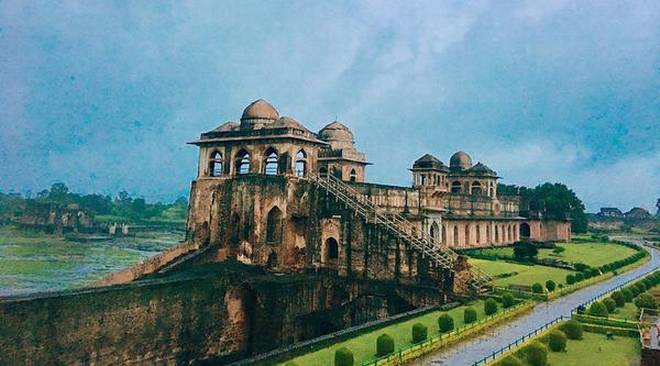Mandu (Dhar District), MADHYA PRADESH :
No rainy day can be better spent than roaming around Mandu’s Jahaz Mahal, with Jahangir’s words as guide
“What words of mine can describe the beauty of the grass and green flowers? They clothe each hill and dale, each slope and plain. I know of no place so pleasant in climate and so pretty in scenery as Mandu in the rainy season,” wrote Jahangir in his memoirs.
On a misty morning in July, we entered the hilly kingdom of Mandu with these words echoing in my mind.
In 1401, Dilawar Khan, the governor of Malwa who was appointed by the Delhi Sultans, took advantage of the chaos resulting from Mongol attacks and declared his independence. He shifted the capital from Dhar to Mandu (Mandav) and renamed it Shadiabad, or City of Joy. When Ghiyasuddin Shah (1469-1500 AD) came to the throne, he decided that his father, Mahmud Shah I, had expanded the kingdom enough. All he wanted to do was enjoy life. Handing over the affairs of the kingdom to his son and heir, Nasir Shah, Ghiyasuddin Shah gave himself up to a life of delights. He was a connoisseur of food, and his recipes are sealed in an illustrated book, Nimatnama, that is with the British Library and has been translated into English by Norah M. Tiley as The Sultan’s Book of Delights.
A life of pleasure
Ghiyasuddin Shah wasn’t joking when he declared that he wanted to devote himself to a life of pleasure. He filled his harem with women who were trained in various disciplines for which they had an aptitude. While some were singers, dancers, painters and chefs, others were trained to be his guards and personal soldiers. He established a madarsa and educated the women to be proficient in religious as well as secular subjects. There were Qazis, schoolmistresses, hunters, scholars, embroiderers, and accountants among them.
We drove straight to Jahaz Mahal, a stunning building, named as such because its shape, when it fell on the water tanks surrounding it, looked like a ship.
All the guides and stories will tell you that Ghiyasuddin Shah built it to house his harem. A probably exaggerated figure of his harem was given by Jahangir, who wrote it as 15,000. That figure is gleefully quoted by local guides, with perhaps a hint of envy on their faces.
After Dilawar Khan established the Malwa dynasty he got architects and craftsmen from Delhi. The early buildings bear a stamp of the Tughlaq and Khilji architecture of Delhi.
The Jahaz Mahal, however, is a flight of imagination and takes yours along with it. I could see girls dancing and singing in the rain on the rooftop and in the courtyards, their shadows reflecting on the Munj Talao and Kaphur Taloo surrounding it.
The strains of Megh Malhar were flooding my senses, and in my mind’s eye I could see the arcades being lit up by the lanterns and lamps that were floating on the water, glimmering and dipping along with the wind, glowing like fireflies.
I could smell the heavily laden kadhais (woks), with samosas and baras being fried. As the illustrations of the Nimatnama show, the Sultan took a keen interest in, and was perhaps supervising, the correct temperature of the oil, the salt in the filling. How golden was the result?
Who knows? All I know is that I was transported back to the 15th century as soon as I entered the long, double-storied Jahaz Mahal through its main arched, marble entrance. At the back, every arch of the continuous arcaded 360-feet building opens on to Munj Talao. I don’t know how close it was originally to Kaphur (Camphor), now called Kapoor Talao, but now this is quite a distance from it. There are manicured lawns between it.
Initially it was decorated with glazed tiles and colourful friezes. Now we have the unfortunate graffiti that people are wont to inscribe on monuments. The cool corridors and pillared compartments were made for dancing and singing.
Nur Jahan accompanied Jahangir to Mandu in 1617 and the palace complex of Mandu enchanted the royal couple.
A magical bubble
Jahangir sent Abdul Karim in an advance party to repair the buildings. He was so pleased with the result that he rewarded him with the title of Ma’mur Khan (architect Khan). Mandu is a treasure house of water harvesting. There are also bathing tanks. There are two in this palace, on both the floors, shaped like a tortoise with steps going in. Now devoid of water, one can imagine women going to the toilet there, with roses and lotus flowers floating in the perfumed waters.
The roof has a few open pavilions and kiosks on its four corners. While I was there on the wet, open terrace, the mist came and blotted out everything around. We were trapped in our very own magical bubble.
source: http://www.thehindu.com / The Hindu / Home> Opinion – Where Stones Speak / by Rana Safvi / September 03rd, 2017









